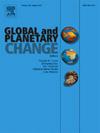Error estimation and data fusion of root zone soil moisture products over China based on the three corned hat method
IF 4
1区 地球科学
Q1 GEOGRAPHY, PHYSICAL
引用次数: 0
Abstract
Root zone soil moisture (RZSM) plays a critical role in numerous ecological and environmental processes and holds significant importance for agriculture, hydrology, and climate studies. Although it can be estimated by hydrology or land surface models, the accuracy of such estimations is often limited. Data fusion offers a promising approach to improving RZSM estimation accuracy, yet few studies have explored this avenue. In our study, we address this gap by providing error estimation and data fusion for five RZSM datasets (ERA5-Land, MERRA2, CFSR, SMAP, GLDAS_NOAH2.1 (NOAH)) using the Three Cornered Hat (TCH) method. We evaluated the performance of the TCH method in assessing RZSM data products and in RZSM merging. Our results demonstrate that the TCH method accurately assesses the performance of RZSM products as validated against in situ measurements. Both in situ-based RMSE and TCH-based uncertainties reveal that MERRA2 and NOAH exhibit the best performance, followed by SMAP, CFSR and ERA5, with uncertainty medians of 0.019, 0.0187, 0.023, 0.021 and 0.028 (m3/m3), respectively. Comparisons of the accuracy for the TCH merged result and the individual RZSM product indicate that the merged result outperforms each individual product. The percentages of RMSE differences between the TCH merged result and the individual products less than −0.005 are 60.8 %, 62.3 %, 36.8 %, 41.7 %, and 51.2 % for CFSR, ERA5-Land, MERRA2, NOAH, and SMAP, respectively. These are significantly higher than the percentages of RMSE differences greater than 0.005. Given the TCH method's independence from in situ measurements, it is a promising option for RZSM data fusion. Overall, our study underscores the potential of the TCH method in evaluating RZSM products and performing data fusion to enhance RZSM estimation accuracy.
基于三顶玉米帽法的中国根区土壤水分产品误差估计与数据融合
根区土壤湿度(RZSM)在许多生态和环境过程中起着关键作用,在农业、水文和气候研究中具有重要意义。虽然它可以通过水文或陆地表面模型来估计,但这种估计的准确性往往是有限的。数据融合为提高RZSM估计精度提供了一种很有前途的方法,但很少有研究对此进行探索。在我们的研究中,我们通过使用三角帽(TCH)方法对五个RZSM数据集(ERA5-Land, MERRA2, CFSR, SMAP, GLDAS_NOAH2.1 (NOAH))进行误差估计和数据融合来解决这一差距。我们评估了TCH方法在评估RZSM数据产品和RZSM合并中的性能。我们的研究结果表明,TCH方法准确地评估了RZSM产品的性能,并通过原位测量进行了验证。基于情景的RMSE和基于tchh的不确定性均显示MERRA2和NOAH表现最佳,其次是SMAP、CFSR和ERA5,不确定性中值分别为0.019、0.0187、0.023、0.021和0.028 (m3/m3)。对TCH合并结果和单个RZSM产品的精度进行比较表明,合并结果优于单个产品。CFSR、ERA5-Land、MERRA2、NOAH和SMAP与TCH合并结果的RMSE差值分别为60.8%、62.3%、36.8%、41.7%和51.2%。这些显著高于RMSE差异大于0.005的百分比。考虑到TCH方法与现场测量的独立性,它是RZSM数据融合的一个很有前途的选择。总的来说,我们的研究强调了TCH方法在评估RZSM产品和执行数据融合以提高RZSM估计精度方面的潜力。
本文章由计算机程序翻译,如有差异,请以英文原文为准。
求助全文
约1分钟内获得全文
求助全文
来源期刊

Global and Planetary Change
地学天文-地球科学综合
CiteScore
7.40
自引率
10.30%
发文量
226
审稿时长
63 days
期刊介绍:
The objective of the journal Global and Planetary Change is to provide a multi-disciplinary overview of the processes taking place in the Earth System and involved in planetary change over time. The journal focuses on records of the past and current state of the earth system, and future scenarios , and their link to global environmental change. Regional or process-oriented studies are welcome if they discuss global implications. Topics include, but are not limited to, changes in the dynamics and composition of the atmosphere, oceans and cryosphere, as well as climate change, sea level variation, observations/modelling of Earth processes from deep to (near-)surface and their coupling, global ecology, biogeography and the resilience/thresholds in ecosystems.
Key criteria for the consideration of manuscripts are (a) the relevance for the global scientific community and/or (b) the wider implications for global scale problems, preferably combined with (c) having a significance beyond a single discipline. A clear focus on key processes associated with planetary scale change is strongly encouraged.
Manuscripts can be submitted as either research contributions or as a review article. Every effort should be made towards the presentation of research outcomes in an understandable way for a broad readership.
 求助内容:
求助内容: 应助结果提醒方式:
应助结果提醒方式:


